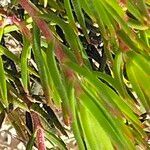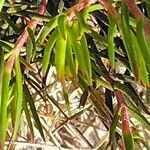Perennial dwarf shrub, succulent, fastigiate branches, erect or decumbent, woody stems, ± 0.2-1.0 m high, old leaves not deciduous, recurved hairs in 2 lines along internodes from fused basis of leaf pairs. Leaves subulate, linear-lanceolate, 5-20 x 1-2 mm, obtuse or rounded, dorsiventrally flattened to almost terete, marginal cilia or papillae, acute apex recurved, grey-green to brown. Inflorescence a rounded thyrse, several dichasia; many flowers; peduncle indistinct. Calyx acute, fleshy, glabrous, green to brown, rarely marginal teeth. Corolla tubular, fused 0.5 mm, cream-coloured tinged pink; lobes elliptic to panduriform, 3.0-4.5 mm long, acuminate, without dorsal appendage, erect to scarcely recurved. Flowering time Oct.-Dec.
Shrublet sometimes to 1 m. Leaves opposite, linear-lanceolate, mostly round in section, with stout marginal cilia or papillae. Flowers in rounded, head-like clusters, cream-coloured, tubular, ± 4 mm long.


